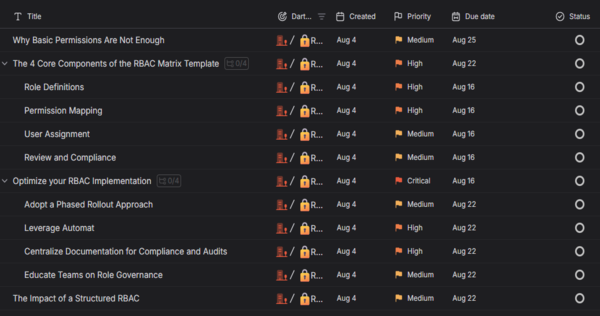Continuous improvement isn’t just one of the best business practices you need to prioritize; it has become a necessity. Yet, many teams struggle with visibility, accountability, and structured progress tracking.
Our continuous improvement board template transforms scattered ideas into a structured workflow. It ensures that every enhancement, big or small, is captured, prioritized, and executed efficiently.
Continuous improvement in action: A step-by-step guide
This template helps you implement a systematic approach to refining processes, products, and performance.
1. Identify improvement opportunities
Capture and categorize ideas from all levels of the organization:
- Process inefficiencies (e.g., bottlenecks, redundancies)
- Customer feedback (e.g., recurring complaints, feature requests)
- Employee suggestions (e.g., workflow pain points, automation opportunities)
- Performance gaps (e.g., missed KPIs, quality issues)
2. Prioritize with the impact-effort matrix
Focus on high-impact, low-effort wins first:
3. Assign ownership & track progress
Ensure accountability with clear deadlines and responsible parties:
4. Measure & validate results
Track success with quantifiable metrics:
- Before vs. After Comparison (e.g., time saved, error reduction)
- Customer/Employee Feedback (e.g., satisfaction scores)
- ROI Calculation (e.g., cost savings, revenue impact)
Implementation roadmap: From ideas to impact

Turning improvement ideas into measurable results requires more than just good intentions, it demands a structured, actionable plan. Without a clear roadmap, even the best initiatives can stall due to unclear ownership, shifting priorities, or lack of follow-through.
Phase 1: Setup & ideation
Lay the foundation by structuring how improvements are captured and organized.
- Define improvement categories (Process, Product, Customer, Employee).
- Set up a submission system (e.g., digital board, team meetings).
- Train teams on how to identify and submit improvements.
Phase 2: Prioritization & planning
Turn raw ideas into actionable plans with clear ownership and timelines.
- Hold a monthly review session to assess and prioritize ideas.
- Assign clear owners & deadlines for each initiative.
- Integrate with project management tools (e.g., Trello, Jira, Asana).
Phase 3: Execution & monitoring
Drive progress through consistent tracking, visibility, and recognition.
- Weekly check-ins to track progress.
- Visual dashboards for transparency (e.g., Kanban board).
- Celebrate quick wins to maintain momentum.
Phase 4: Review & scale
Learn from results, refine strategies, and expand successes across the organization.
- Monthly retrospective: What worked? What didn’t?
- Document best practices for future improvements.
- Scale successful changes across departments.
Why most improvement efforts fail
The gap between identifying opportunities and achieving meaningful progress often comes down to three critical failures, each of which this template systematically addresses.
1. No structured process → ideas get lost in emails or meetings
Lack of organization leads to duplicated efforts, overlooked opportunities, and frustration among teams who feel their input isn’t valued.
How This Template Helps:
- Centralized Tracking: A single, visible board captures all improvement ideas, eliminating guesswork about where to submit or find them.
- Clear Workflows: Standardized stages (e.g., "Submitted," "In Review," "In Progress," "Completed") ensure nothing falls through the cracks.
2. Lack of accountability → no one owns the improvements
Even the best ideas fail without clear responsibility. When tasks are vaguely assigned or lack deadlines, teams assume someone else will handle them, resulting in inertia and missed opportunities.
How This Template Helps:
- Assigned Owners: Every improvement initiative has a designated leader, preventing ambiguity about who drives action.
- Deadline-Driven: Time-bound commitments create urgency and focus, transforming vague intentions into concrete plans.
3. No measurable outcomes → inability to prove ROI
Without tracking impact, organizations can’t distinguish between busywork and genuine progress. Teams waste resources on changes that don’t move the needle, while successful efforts go unrecognized.
How This Template Helps:
- Built-in Success Metrics: Predefined fields for baseline and post-improvement data quantify results.
- Reporting Framework: Structured documentation manages risks, highlights wins, justifies resource allocation, and identifies patterns for future improvements.
Your improvement begins now
Stop letting great ideas slip through the cracks. Our continuous improvement board template turns incremental progress into transformative results.
Start improving smarter!







